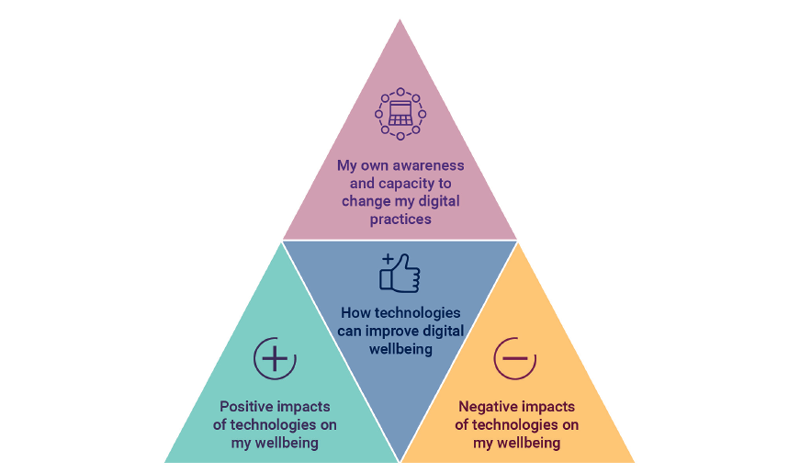Promoting digital wellbeing for learners
Last updated:
How to ensure learners get the support they need to use digital in a healthy and mindful way.
The issue
Digital technologies present many opportunities for new ways of working. Understanding the positive benefits and any potential negative aspects of engaging with digital activities is key to ensuring learner wellbeing.
The impact of technologies and digital services on people’s mental, physical, social and emotional health can be wide-ranging. The challenge for universities and colleges is to keep pace with technology whilst providing learners with the support they need to use digital in a healthy and mindful way.
What you can do
It can be difficult to know where to begin when approaching how digital will impact on individuals. Jisc has developed a model showing the four aspects of digital wellbeing for individuals.

Text description for four aspects of digital wellbeing for individuals model
- My own awareness and capacity to change my digital practices
- How technologies can improve digital wellbeing
- Positive impacts of technologies on my wellbeing
- Negative impacts of technologies on my wellbeing
- My own awareness and capacity to change my digital practices
- How technologies can improve digital wellbeing
- Positive impacts of technologies on my wellbeing
- Negative impacts of technologies on my wellbeing
More information on this model, and briefing papers for both practitioners and senior leaders, can be found on the building digital capability website. These resources provide you with a starting point and outline some good practice principles to help inform your own planning and processes.
Understand your role
Ensuring digital wellbeing involves the responsibility of a number of departments and roles within the organisation, including a certain degree of self-regulation too.
Meeting with students online may cause concerns about breaching boundaries or questions about etiquette. It’s important to ensure that both staff and students are protected and understand how to maintain boundaries online.
It is important to recognise that some students with learning needs and differences may require additional support, supervision or guidance to participate safely online. Staff digital literacy and awareness are key to maximising these student’s digital independence.
You should consider providing a range of straightforward ways for learners to report concerns about their own wellbeing or someone else’s wellbeing.
Read our blog post Are your staff digitally ready to communicate with learners online? which includes top tips on how to maintain boundaries and further resources.
Westminster College provides all learners with an online agreement to sign, covering aspects such as online bullying, privacy and online etiquette, so learners are clear about what is expected of them and know where they can go for further support.
Prevent duty
The Home Office provides detailed guidance for further and higher education institutions in England, Scotland and Wales on what is expected in order to fulfil the Prevent duty.
Our community blog will help you stay up to date with legal and technical requirements.
Provide training
Be clear about what is expected of staff and students in your guidelines and deliver relevant training. Provide a named contact responsible for the policy and procedures contained within so all staff know who to contact for further guidance.
Supporting learners’ digital identity and wellbeing is a key driver for organisations who want to prepare their learners for the digital workplace. Jisc provides an online workshop to explore ways in which technology-enhanced learning can support the development of learners’ digital identity and wellbeing.
Further resources and case studies
- Read our blog post Taking the detective work out of supporting mental health and wellbeing
- The universities of Leeds, York and Manchester have worked together, and with their students to produce an interactive guide to social media. This is for use at any stage in a course of study but is particularly targeted at new students
- The University of Suffolk has developed the higher education online safeguarding self-review tool, a checklist on policies and practices
- Universities UK offers a set of principles and practical recommendations to enable universities to prevent and respond to online harassment occurring between students